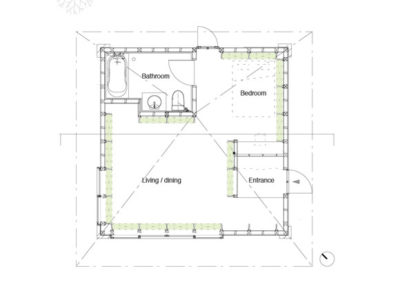
IPFS News Link • Building and Construction Materials
"A Recipe To Live": Straw Houses Reduce Energy Use, Combat Climate Change
• http://www.trueactivist.comA fully functional straw house was designed and built by students of Waseda University in Japan.
Masaki Ogasawara, Keisuke Tsukada and Erika Mikami are the masterminds behind this environmentally-friendly and functional design, combining straw bales with different materials to make a practical and almost entirely biodegradable single-story home. The project, known as "A Recipe to Live", is now being reproduced internationally.
Although straw bales have been used among the years for construction purposes, particularly in rural areas, the students of Waseda University were able to perfectly combine every material.
Using the "bokashi method" – fermented organic matter – Japanese students created a house suitable for diverse weather conditions, including hot summers and extreme winter temperatures. Everything within the house has a purpose, from the materials, to the design itself.

http://bit.ly/Otewih
The country-inspired yet futuristic house is located in Taiki-cho town on Hakkaido Island in Japan and is mainly composed of dry straw walls. Additionally, the students included acrylic boxes, which act as a "heat shield panel" and the Japanese organic matter, bokashi.
Interacting with the process of fermentation instead of putrefaction is one of the main reasons why the students preferred to use bokashi for this type of construction. This method, if kept in an anaerobic state, helps to prevent any smells from emerging.
Bokashi – also known as "Ekiji" – is a mixture of biological microorganisms, generally used in composting processes. It is capable of decomposing any type of waste without the need for oxygen. Additionally, bokashi remains odorless and is more economic than any other method, as it doesn't require human interaction.
In winter, the straw walls begin the process of fermentation. This chemical reaction provides natural heat (up to 30°C or 86°F) for a period of four weeks. During the summer, the acrylic window shelves humidify the environment, filling the interior with a cool sensation.
Although it seems like it might be difficult to maintain a house with these characteristics, it pays for itself as it requires significantly less energy than traditional homes.
In this context, in Bristol, UK, houses made by straw bricks have already gone on the market. A research project guided by students at the University of Bath in cooperation with the architectural firm Modcell, have successfully created traditional one-story straw houses.
Read More: http://www.trueactivist.com/a-recipe-to-live-straw-houses-reduce-energy-use-combat-climate-change/
































1 Comments in Response to "A Recipe To Live": Straw Houses Reduce Energy Use, Combat Climate Change
This shows you how far the Japanese are behind the Chinese. The Chinese did this long ago in their building of the Great Wall.